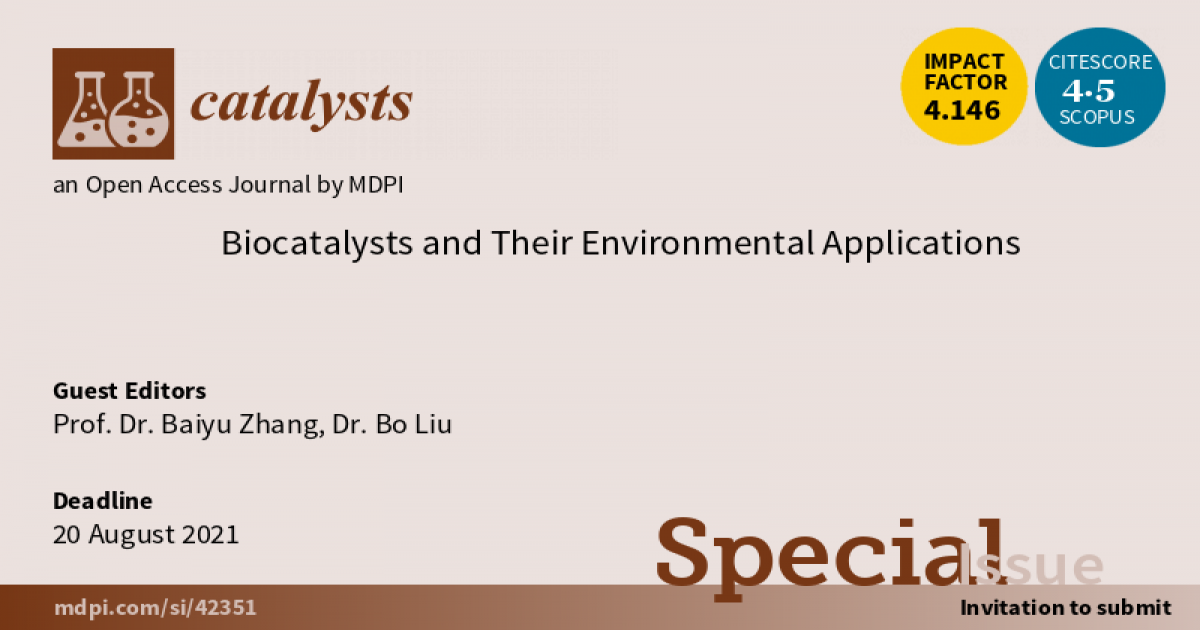Biocatalysts and Their Environmental Applications
A special issue of Catalysts (ISSN 2073-4344). This special issue belongs to the section "Biocatalysis".
Deadline for manuscript submissions: closed (20 August 2021) | Viewed by 43010

Special Issue Editors
Interests: magnetic nano-biocatalysts; bioremediation
Interests: photocatalytic oxidation; nanomaterials; energy recovery from water and wastewater treatment; emerging contaminants; system design
Special Issues, Collections and Topics in MDPI journals
Special Issue Information
Dear Colleagues,
Biocatalysts, including a special species of microorganisms, and their enzymes have been widely accepted in many industrial processes, because they are less-toxic, environment friendly, and energy-conserving alternatives compared with chemical catalysts. Whole-cell biocatalysts have advantages (e.g., the elimination of the need for protein purification) and disadvantages (e.g., the reduced reaction rates) over purified enzymes.
The reaction rates in whole-cell biocatalysts can be achieved through many strategies, such as increasing the permeability of the cell membrane by chemical reactions; increasing the concentration of the enzyme within the cell by enzyme overexpression in a bacterial host; and stabilizing and improving the biocatalyst function by flocculation, surface immobilization, and encapsulation. Up unil now, whole-cell biocatalysts have been applied to environmental fields for enhancing transformation and degradation processes. Meanwhile, the growth synthetic biology and protein engineering greatly facilitates the development of novel biocatalysts specifically relevant to the production of fine chemicals for improving bulk enzymes for industry and the products involved in waste reduction and detoxification. Magnetic nano-biocatalysts are also a rapidly growing field for the development of sustainable and green processes.
This Special Issue will focus on different methodologies for biocatalyst development/improvement, and a large range of reactions employed in environmental remediation processes catalyzed by whole-cells and isolated enzymes. Persistent, toxic/carcinogenic, and/or bio-accumulative contaminants in multiple (air/liquid/solid) phases will be tackled. It aims to compile a set of manuscripts that cover the recent progress and trends in biocatalysts, and their environmental applications.
Dr. Dr. Baiyu Zhang
Dr. Bo Liu
Guest Editors
Manuscript Submission Information
Manuscripts should be submitted online at www.mdpi.com by registering and logging in to this website. Once you are registered, click here to go to the submission form. Manuscripts can be submitted until the deadline. All submissions that pass pre-check are peer-reviewed. Accepted papers will be published continuously in the journal (as soon as accepted) and will be listed together on the special issue website. Research articles, review articles as well as short communications are invited. For planned papers, a title and short abstract (about 100 words) can be sent to the Editorial Office for announcement on this website.
Submitted manuscripts should not have been published previously, nor be under consideration for publication elsewhere (except conference proceedings papers). All manuscripts are thoroughly refereed through a single-blind peer-review process. A guide for authors and other relevant information for submission of manuscripts is available on the Instructions for Authors page. Catalysts is an international peer-reviewed open access monthly journal published by MDPI.
Please visit the Instructions for Authors page before submitting a manuscript. The Article Processing Charge (APC) for publication in this open access journal is 2200 CHF (Swiss Francs). Submitted papers should be well formatted and use good English. Authors may use MDPI's English editing service prior to publication or during author revisions.
Keywords
- whole cell biocatalysts
- enzymes
- magnetic nano-biocatalysts
- environmental applications
- contaminant transformation and degradation
Benefits of Publishing in a Special Issue
- Ease of navigation: Grouping papers by topic helps scholars navigate broad scope journals more efficiently.
- Greater discoverability: Special Issues support the reach and impact of scientific research. Articles in Special Issues are more discoverable and cited more frequently.
- Expansion of research network: Special Issues facilitate connections among authors, fostering scientific collaborations.
- External promotion: Articles in Special Issues are often promoted through the journal's social media, increasing their visibility.
- e-Book format: Special Issues with more than 10 articles can be published as dedicated e-books, ensuring wide and rapid dissemination.
Further information on MDPI's Special Issue policies can be found here.






